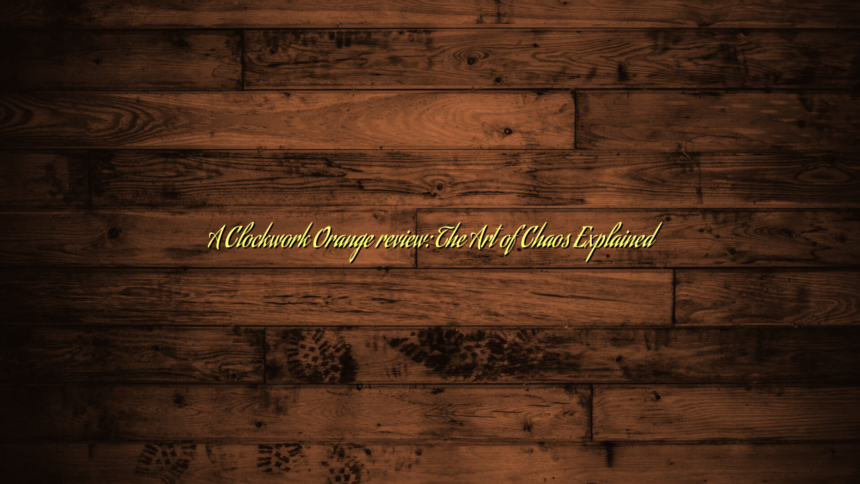A Clockwork Orange review
Stanley Kubrick’s A Clockwork Orange is usually hailed as a cinematic masterpiece, a movie that delves into the chaotic realms of free will, morality, and societal management. Based mostly on Anthony Burgess’s 1962 novel, this adaptation unleashes a dystopian perspective that has captivated and disturbed audiences since its launch in 1971. This text provides a complete A Clockwork Orange assessment that explores the aesthetics of chaos, the themes of management, and the creative brilliance that defines this iconic movie.
The Dystopian Panorama of A Clockwork Orange
Setting the Stage
From the second the movie begins, viewers are thrust right into a grim, dystopian future the place the traces between good and evil blur tragically. The gritty city setting, accentuated by Kubrick’s meticulous cinematography, serves not simply as a backdrop however as a personality in its personal proper. This bleak setting mirrors the protagonist, Alex DeLarge, and a society spiraling uncontrolled.
The Artwork Course
The artwork route in A Clockwork Orange is synonymous with chaos. Vibrant colours juxtaposed with grotesque imagery create a disorienting impact that traps the viewer in Alex’s twisted world. The placing costumes, notably the bowler hats and distinctive eye make-up of the droogs, additional emphasize deviance in a society that’s in any other case sterile and oppressive.
Thematic Depth: Free Will vs. Management
The Idea of Free Will
At its core, A Clockwork Orange challenges the viewers’s notion of free will. Alex, portrayed brilliantly by Malcolm McDowell, embodies the notion of unrestrained freedom—even when his freedom results in grotesque violence. The movie poses essential questions: Is it acceptable to strip away somebody’s free will for the sake of societal order? And might an individual be rehabilitated if they’re compelled to forsake their inherent nature?
The Ludovico Approach: A Questionable Remedy
The introduction of the Ludovico Approach—a controversial methodology of aversion remedy geared toward curbing Alex’s violent impulses—is a pivotal second within the story. Because the “remedy” unfolds, it turns into evident that eliminating free will results in ethical dilemmas. Kubrick’s chilling portrayal of this system brilliantly showcases the chaos that outcomes when society makes an attempt to manage particular person actions.
Character Evaluation: The Chaotic Protagonist
Alex DeLarge: A Layered Antagonist
On this A Clockwork Orange assessment, Alex DeLarge stands out as an extremely complicated character. He’s each fascinating and repulsive, an enthralling sociopath who evokes each empathy and disgust. His love for classical music, particularly Beethoven, provides layers to his character, revealing a possible for deeper appreciation that transcends his violent façade.
The Droogs: A Reflection of Society
Alex’s companions, the droogs, symbolize the chaos and immorality rampant in society. Their uncooked and chaotic nature serves as a critique of the corrupted youth tradition of the time. The group dynamic highlights themes of loyalty, betrayal, and the fragility of friendship inside the context of an anarchic way of life.
Cinematic Methods: Crafting Chaos
Visible Mastery
Kubrick’s visible storytelling is nothing wanting genius. From lengthy, haunting pictures to disconcerting close-ups, the movie’s cinematography enhances its chaotic themes. The usage of contrasting lighting—tender but jarring—provides emotional depth and provokes a visceral response from the viewers.
Symbolism and Irony
Symbolism performs a major position in A Clockwork Orange. The recurring motif of classical music juxtaposed with scenes of violence is especially noteworthy. This ironic pairing not solely amplifies the chaos but additionally invitations viewers to query the character of artwork and its relationship to morality.
Race, Class, and Gender: Societal Reflections
A Commentary on Class Disparities
The movie additionally serves as a critique of societal hierarchies. The varied lessons depicted all through the narrative illustrate how energy constructions contribute to chaos. These in authority, such because the police and politicians, typically exhibit as a lot ethical corruption because the criminals they search to manage.
Gender Dynamics
The portrayal of girls in A Clockwork Orange has garnered criticism for its objectification and violence. Nevertheless, this portrayal opens up discussions about gender roles and the dehumanizing results of a chaotic society. The movie forces the viewers to confront uncomfortable truths concerning the intersection of chaos, energy, and gender.
The Legacy of A Clockwork Orange
Cultural Influence
A Clockwork Orange has left an indelible mark on widespread tradition. Its controversial themes, distinctive visible fashion, and haunting rating have influenced quite a few filmmakers and artists. The movie stays some extent of reference in discussions about censorship, viewers interpretation, and the moral obligations of artists.
Ongoing Relevance
Many years after its launch, A Clockwork Orange resonates with up to date audiences going through related questions on freedom and management. Points comparable to surveillance, private autonomy, and societal violence are extra urgent than ever, making the movie’s commentary startlingly pertinent in at this time’s context.
Concluding Ideas
Unpacking the Chaos
On this detailed A Clockwork Orange assessment, we’ve explored the myriad methods during which Kubrick’s movie encapsulates chaos in each its narrative and aesthetics. By difficult societal norms and delving into the tumultuous depths of human nature, A Clockwork Orange forces us to confront uncomfortable truths about free will and ethical selection.
Actionable Insights
To raised respect A Clockwork Orange, contemplate revisiting the movie with a watch for its cinematic methods and thematic layers. Mirror on the ethical questions it raises—how does chaos manifest in at this time’s society? What can we study from Alex’s journey concerning the significance of compassion amidst management? By participating with these themes, viewers can unlock a deeper understanding of this timeless basic.
In conclusion, Stanley Kubrick’s A Clockwork Orange isn’t just a movie; it’s a lens by means of which we are able to discover the complexities of chaos and management in our lives. Whether or not you are a first-time viewer or a seasoned fan, the journey by means of Alex DeLarge’s tumultuous existence will depart you questioning the character of freedom, morality, and society itself.




